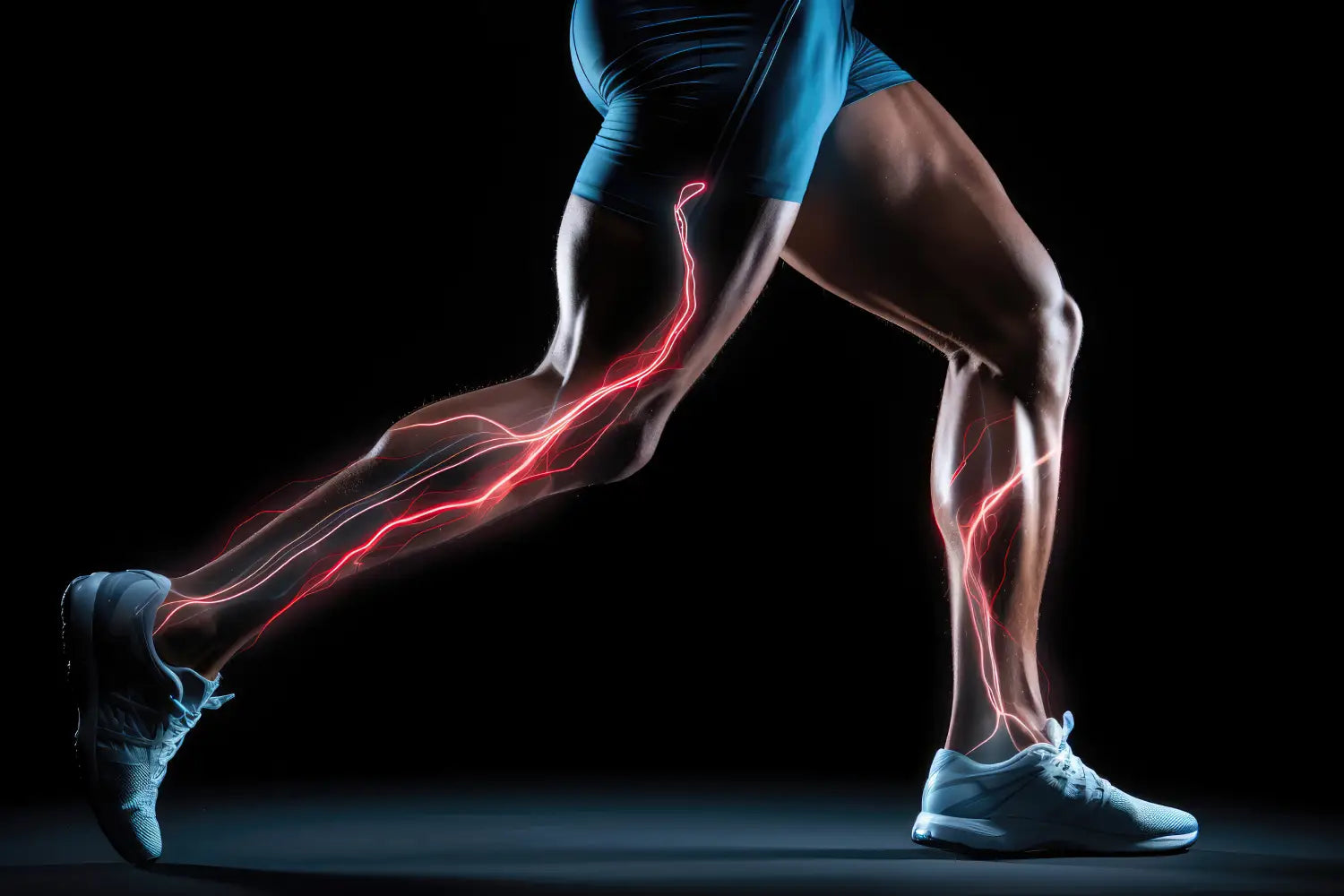Medically Reviewed By | Johannah Gregg, DNP FNP-C
Navigating the journey with Patellar Tracking Disorder can feel challenging, but understanding your condition and being equipped with the right tools can make a world of difference.
Not sure where to start? Incrediwear has you covered with this guide – providing insight into the causes and symptoms of this Patellar Tracking Disorder, as well as actionable strategies for managing discomfort and maintaining an active lifestyle.
Let’s dive in.
What Is Patellar Tracking Disorder?
Patellar Tracking Disorder, also known as Patellofemoral Pain Syndrome, is a condition where the kneecap (patella) doesn't stay within the groove on the thighbone. It might shift sideways when you bend or straighten your knee, causing discomfort and, at times, a sense of instability.
What Are Common Signs of Patellar Tracking Disorder?
Common symptoms include pain in the front of the knee, which might intensify when walking, climbing stairs, kneeling, or even sitting for extended periods. Some people may experience a feeling of cracking or popping and a sensation of the knee 'giving out’ – which can lead to an unsettling feeling of instability.
These symptoms can significantly impact your daily activities, making even everyday tasks seem challenging and your overall quality of life.
While the impact of these symptoms may affect your physical and mental well-being, remember that you're not alone in this journey. With the right tools and strategies, managing these symptoms and leading full, active lives is possible.
Learning about the numerous methods available to help cope with knee discomfort and taking proactive steps to find which strategies work best for you can help ease discomfort and enhance your knee health.
What Can Cause Patellar Tracking Disorder?
Patellar Tracking Disorder can be influenced by a variety of factors. Understanding these factors can be the first step towards managing the condition effectively.
Some of the most common causes include:
- Muscle imbalance: Sometimes, the muscles around the knee can develop unevenly. For instance, if the muscles on the outside of the knee are stronger than those on the inside, they can pull the patella out of its normal track. This imbalance can result from genetics, a lack of proper training, or a previous injury.
- Injury: Direct trauma to the knee, such as a dislocation or fracture, can damage the structures that keep the patella in place, leading to Patellar Tracking Disorder. Even after the injury heals, the knee might not function exactly as before, making appropriate rehabilitation and support critical to prevent future problems.
- Overuse: Repetitive stress on the knee, often seen in athletes or individuals whose work or hobbies involve frequent kneeling or squatting, can lead to wear and tear over time. This constant strain can gradually affect the patella alignment, leading to Patellar Tracking Disorder.
- Incorrect alignment due to individual anatomical differences: Everyone's body is unique, and these differences can affect how the patella tracks over the knee. Some people might have a wider pelvis, flat feet, or a patella that's naturally positioned higher than usual (patella alta). These individual differences can contribute to the development of Patellar Tracking Disorder.
How Can You Manage Discomfort Associated With Patellar Tracking Disorder?
Stepping towards greater comfort and relief. Using supportive wearables and practicing targeted exercises makes your path to navigating Patellar Tracking Disorder clearer and more manageable.
Wear a Knee Brace or Sleeve
Proper knee support plays a crucial role in maintaining overall joint health. The support of a well-designed sleeve or brace can help maintain the knee alignment, support the joint during movement, and potentially soothe feelings of discomfort.
It's especially critical when dealing with conditions like Patellar Tracking Disorder, where the knee's usual alignment might be compromised. Knee Sleeves are designed to support the patella during activity, support healthy blood flow, and soothe discomfort. Many physical therapists recommend wearing a supportive sleeve or brace when dealing with this condition, but it’s important to note that sleeves cannot treat PTD.
Wear Suitable Footwear
Choosing the right footwear can have a significant impact on your knee health. Shoes that provide proper support and fit correctly can help maintain proper alignment of the knee, reducing the stress placed on it during movement.
Shoes with good arch support, for instance, can prevent your feet from rolling inward, a motion that can pull your knee out of alignment. Having specialized footwear on hand or foot for various activities, such as running shoes for your workouts and comfortable, supportive shoes for daily wear, can further enhance knee comfort.
Incorporate Soothing Exercises into your Routine
A well-rounded exercise regimen is essential in managing Patellar Tracking Disorder. Practicing specific stretches and exercises meant to target the knee can help strengthen the muscles around your knee, improve flexibility, and enhance overall joint health.
Consider Physical Therapy
Physical therapy can play a significant part in your recovery process. Therapists can provide personalized exercises and stretches that target the root causes of your knee discomfort.
Maintain a Healthy Weight for You
While a healthy weight looks different for everyone, some evidence suggests that there may be a link between weight and stress on the knees in some cases, which can potentially exacerbate issues like Patellar Tracking Disorder.
Nurturing the bodies through balanced nutrition, embracing a physical activity that feels good, and listening to our bodies can help us naturally move towards or maintain a weight that is healthy for our bodies — which can also aid in relieving the strain on our knees and promote overall knee health.
Try Low-Impact Exercises
Incorporating low-impact exercises such as swimming, cycling, or yoga can help strengthen your knees and improve flexibility without causing additional strain. These exercises put less stress on your joints while still getting your heart rate up, making them an excellent addition to your fitness routine — especially when combined with soothing stretches and the support of good footwear.
Take Regular Breaks
While perseverance is often celebrated, taking a pause can be just as vital. If you're engaged in activities that require you to stand or sit for extended periods, it's crucial to take regular breaks to prevent stiffness.
Taking even a few minutes to practice gentle stretches or walking to the kitchen to refill your water bottle can make a difference. This brief activity gives your knees a change in motion, helping to prevent stiffness and encouraging circulation.
Consultation With Health Professionals
While all of these strategies can help ease discomfort and help you feel your best, professional medical advice is irreplaceable. If you’re struggling with Patellar Tracking Disorder, your healthcare provider can provide a detailed diagnosis, treatment plan, and personalized advice based on your specific situation.
Maintain a Balanced Approach
As with anything, a balance of rest and activity is crucial. Overdoing it can exacerbate your symptoms, so listen to your body and give it the rest it needs.
How Braces Can Support You In Managing Knee Discomfort
Whether you’re enjoying a leisurely walk, engaging in physical therapy, crossing the finish line of a marathon, or just hoping to relax at home without knee discomfort getting in the way, knee braces and sleeves can provide comfort and support when dealing with knee discomfort.
When it comes to coping with Patellar Tracking Disorder, targeting the knee with a knee sleeve can be especially beneficial as it supports blood flow to the knee during physical activity or during breaks from long periods of standing or sitting. By supporting healthy circulation, sleeves and braces can soothe discomfort and support the patella during activity.
Support Your Knee With PTD
While coping with Patellar Tracking Disorder may feel like a lonely solo journey at times, remember that you are not in this alone. Understanding this condition and its causes and signs can empower you to take proactive steps toward managing the discomfort and improving your quality of life.
Simple but effective strategies like choosing supportive footwear, incorporating soothing exercises into your routine, and giving your body the rest it needs can go a long way. Embrace the journey with the support of innovative braces and sleeves that can support circulation and provide the added comfort you deserve.
We’re here to help you keep moving forward – knowing you have the information to lead a fulfilling and vibrant life. With a balance of care, patience, and supportive technology, you can keep moving forward with greater ease, comfort, and joy.
Sources:
Patellofemoral pain syndrome | Mayo Clinic
Every Body is Different | National Eating Disorders Association
Read more

Medically Reviewed By | Dr. Kate Panawash, PT, NCS, DPT Circulation, the vital process that delivers oxygen and nutrients to every cell in our body, plays an undeniable role in maintaining our over...

Medically Reviewed By | Dr. Kate Panawash, PT, NCS, DPT In the bustling modern workplace, repetitive motions have silently woven their way into our daily routines. Just as ball control is pivotal i...





Leave a comment
All comments are moderated before being published.
This site is protected by hCaptcha and the hCaptcha Privacy Policy and Terms of Service apply.